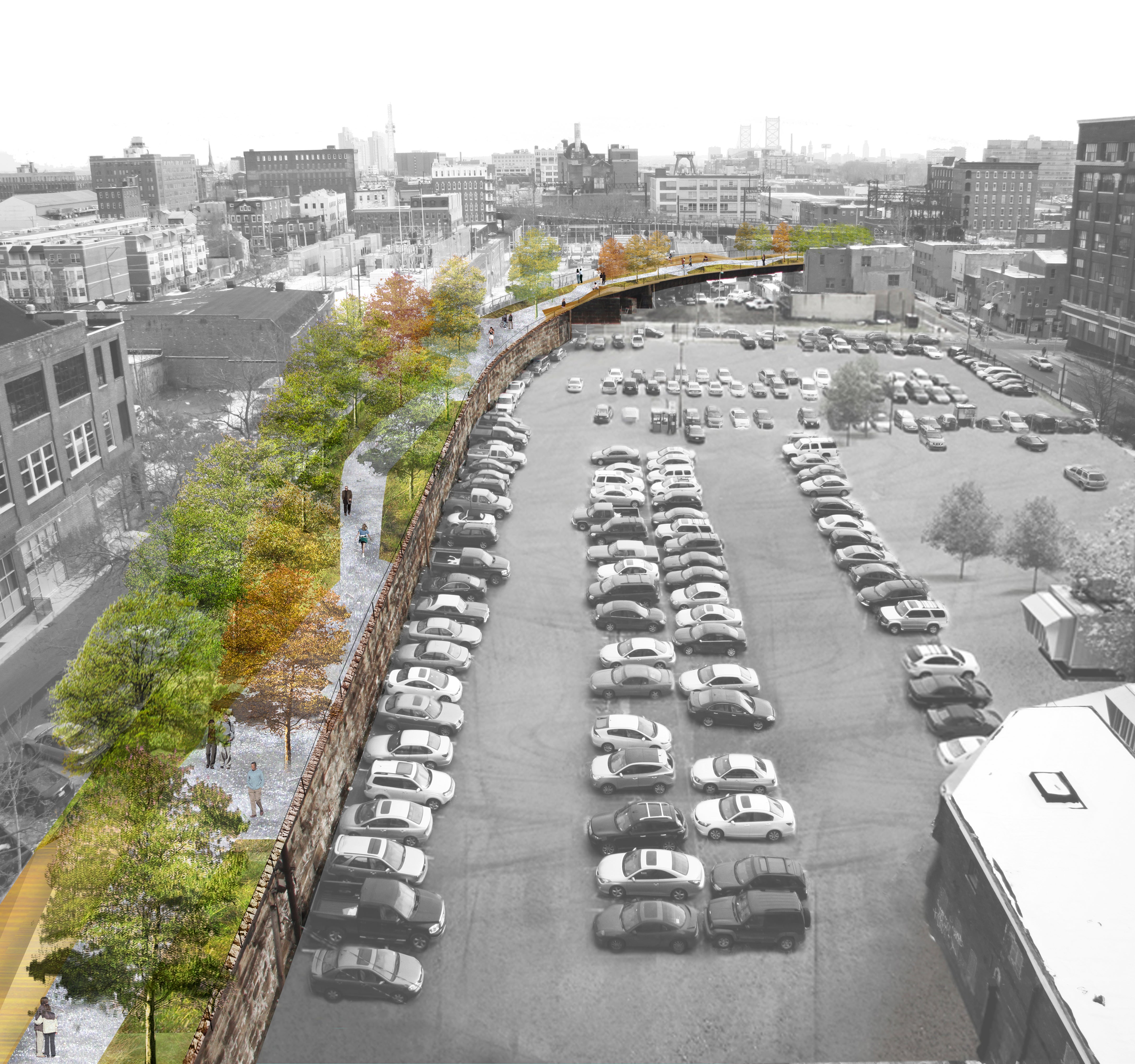Art Commission grants final approval to Reading Viaduct Spur and Market St. Memorial

The Reading Viaduct Spur took another step toward reality Wednesday morning when the Philadelphia Art Commission gave the project the blessing of final approval.
The Spur is a quarter-mile arm of the viaduct that stretches between Broad Street and Callowhill Street.
Wednesday’s presentation described in detail how Phase 1 would incorporate plant material and path surface materials (think chip seal paving) into the project. It also addressed how structual elements (think bridges) would be rehabilitated; how recreational features (benches, swings, lighting) would be strategically placed on the site; how toxics (mostly railroad ballast, very little PCB presence) would be remediated and how the entire spur will be maintained.
The Center City District is still raising money to complete the planned improvements on the first phase of the project. The group has raised about 65 percent of the $9 million it needs for the “SEPTA spur”, and is pursuing a $3.5 million grant from the state’s Redevelopment Assistance Capital Program (RACP), according to John Struble, of Friends of the Rail Park. After the improvements are completed, the city would take over ownership of the park.
SEPTA’s board of directors must also approve the sale of the property. A spokesman for SEPTA said the sale has not yet been scheduled for a board vote but Wednesday, Center City District CEO Paul Levy said that while SEPTA still owns the land it will lease it to the Center City District and upon project completion the land will be conveyed to the city’s Department of Public Property.
A little background from design firm Studio Bryan Hanes, which is handling the Pase 1 work:
Beginning at grade, the space, approximately 30 feet wide, rises until it becomes entirely supported by structure. Much of the material character of the site comes from the existing structure of the elevated rail line. The design restores and maintains much of the existing steel and introduces materials of a similar industrial scale and character for the platforms, benches and guardrails. The vegetation, too, conveys the rugged character of the place through a richly varied plant palette. Corresponding with soil depth constraints, the vegetation on grade is comprised of woody shrubs and trees. As it transitions to structure, the vegetation becomes less dense and features a lighter palette of grasses and perennials.
It should be noted that programmatically, the spur concept remains simple. A walkway is directed between areas of planting and recreation. Four steel supported wooden platforms accentuate the idea of one feeling comfortable in the site. Their free dimensional surfaces create spaces for lounging and gathering. The main walkway culminates in a series of swings which can be seen from the street below.
Watch full video of the hearing below
MARKET STREET MEMORIAL MOVES AHEAD
Just two days before the second anniversary of the building collapse at 22nd and Market streets that killed six people, the Philadelphia Art Commission gave the 22nd & Market Memorial Committee final approval for plans that will create a permanent park commemorating the lives lost and the hope for a better, safer Philadedlphia in the future.
The commissioners were quite appreciative of the work of sculptor Barb Fox and the design team to incorporate recommended changes in the height and density of the memorial’s key components. Those criticism’s came forth during the group’s previous presentation before the Art Commission.
The most important revision to the design? A reduced height [8’-8”]; lowered the seventh window; chamfered the corners on the markers, and better related the geometry of the stones to both the sacred space and the park.
In describing how her approach to the project changed over time, the sculptor viscerally noted that the physical dimensions and the proportions of the memorial stones are essential to the meaning and emotional impact of the experience of the sacred space. And, this is key, by creating an architectural context, the form of a house if you will, provides a needed and rare space for contemplation in the city.
The commissioners unanimously recommended final approval.
The 22nd & Market Memorial Committee is half way towards raising the $1.3 million for the park. As for the timeline for phases: permit drawings will be completed by the end of summer, and with the help from the public in raising the rest of the funds, the committee hopes to start construction in late fall with the goal to open the memorial park on the third anniversary, June 5th, 2016.
The committee:
- Barbara Adams, Esq., General Counsel, Philadelphia Housing Authority
- Jeff Braff, President, Center City Residents Association (CCRA)
- David R. Brigham, Ph.D., President and CEO, Pennsylvania Academy of the Fine Arts
- Robert Coleman, fiancé of victim Kimberly Finnegan
- Thomas A. Decker, Esq., Vice Chairman, Cozen & O’Connor
- Kirk Dorn, Senior Director, Ceisler Media and Issue Advocacy
- Nancy Goldenberg, Vice President Planning and Development, Center City District
- Alexander (Pete) Hoskins, President, Laurel Hill Cemetery
- David Seltzer, Principal, Mercator Advisors, LLC
- Harris M. Steinberg, FAIA, Executive Director, Lindy Institute
- Jerry Sweeney, President, Brandywine Realty Trust
- Rev. Mark Kelly Tyler, Ph.D., Senior Pastor, Mother Bethel African Methodist Episcopal Church
- John White, Chairman, The PFM Group
The Design team:
Pennsylvania Horticultural Society; Philadelphia Parks and Recreation; Scott Aker, Architect; Barb Fox, Artist; Hussam SH. Elkhrraz; Pennoni Associate Engineers (Civil, Structural, Electrical); Synterra Landscape Architects; Signarama, Center City; The Lighting Practice; L.F. Driscoll Co., LLC; Malvern Granite; William Penn Performance Glass; Joel Katz Design; Richard Hunt, Archetype Typography
Watch full video of the hearing below
WHYY is your source for fact-based, in-depth journalism and information. As a nonprofit organization, we rely on financial support from readers like you. Please give today.















